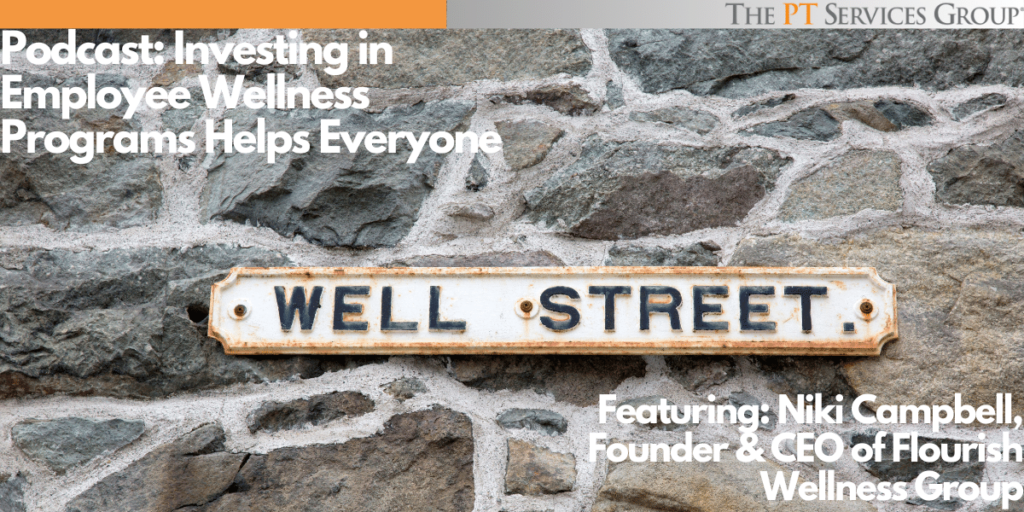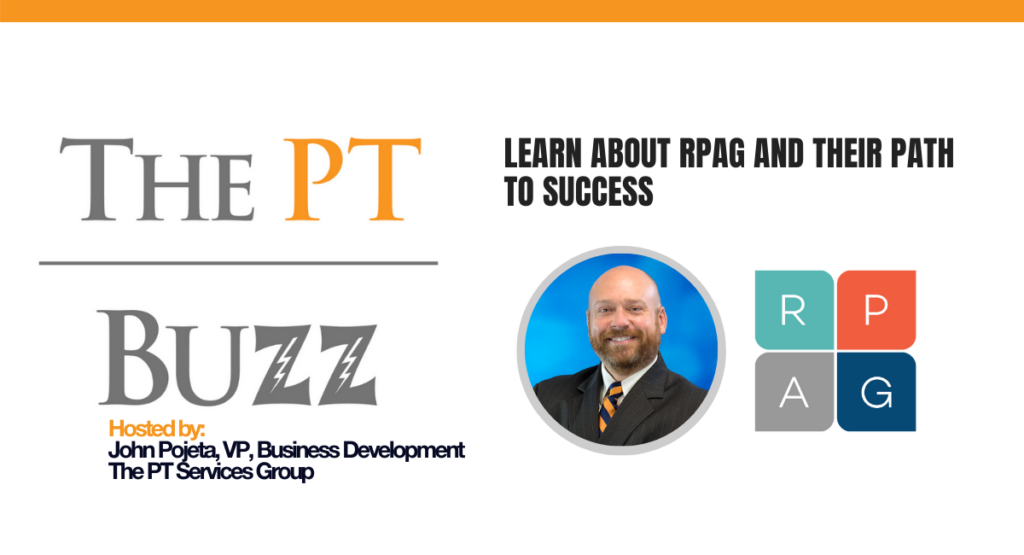In our latest episode, PT welcomes our friend and sales guru, Dan Hudock for a timely conversation about sales in today’s world. Dan and PT’s John Pojeta discuss some of the hurdles sales people are having these days –particularly as a result of the pandemic and the shift to virtual meetings. Dan shares some great insights, including new behaviors that salespeople are succeeding with. It’s a topic that will resonate with anyone who is looking to improve their sales today.
Where to Listen/Subscribe














Podcast Resources:
Any and all resources we mentioned in the podcast can be found here. Looking for something not here? Contact us, we’d love to help you out.
Guest Bios:
 Dan Hudock is owner of Sandler Training, Wexford. Recognized as one of the top Sandler trainers and speakers in the world, Dan is able to provide hard hitting insights into the world of management and selling that few people can equal. Humor, life stories, and a passion for results enable participants to truly change their world. Dan works with many of The PT Services current clients to maximize their impact and growth.
Dan Hudock is owner of Sandler Training, Wexford. Recognized as one of the top Sandler trainers and speakers in the world, Dan is able to provide hard hitting insights into the world of management and selling that few people can equal. Humor, life stories, and a passion for results enable participants to truly change their world. Dan works with many of The PT Services current clients to maximize their impact and growth.
Host John Pojeta’s bio: John researches new types of business and manages and initiates strategic, corporate-level relationships to expand exposure for The PT Services Group. John came to The PT Services Group in 2011. Before that, he owned and operated an Ameriprise Financial Services franchise for 16 years.
Podcast Transcript:
John Pojeta: Hi, John Pojeta here at the PT Services Group. Hope you’re doing really well. And welcome back to another episode of the PT Buzz. And today is a really good conversation with Dan Hudak. And for anybody that doesn’t know, Dan is PT’s outside sales coach who works with PT clients and he owns a Sandler Training franchise.
And it’s a good timing for a conversation with. The sales process side of things, as we’re getting back into face-to-face conversations again, but we’re still doing phone and virtual. And so we really thought the timing was good to get back on the same page on a few things, talk about some new things, things that we’re seeing trends and provide those, those nuggets of things that will help you garner more second appointments, ultimately bring on more clients.
And it’s just a fun conversation, but a very valuable conversation. So hope you enjoy. With that basic backdrop, rather than me trying to tell everybody who you are, Dan, how are you doing number one? And number two. Can you, can you tell everybody a little bit about yourself?
Tap/Click to View Full Transcript
Dan Hudock: So doing great. It’s great to be doing this again with you, John.
It’s probably been well over a year. I would think since we’ve done something so good to be back on the saddle again. Hello everybody. My name is Dan Hudak. I’m a franchisee owner of a Sandler. Training company located in Wexford, Pennsylvania, just north of Pittsburgh by about an hour, and actually wanting to use this as an opportunity to kind of say a lot of the stuff that we’ll be talking about.
It’s not just coming from me. You got to keep in mind that I am, uh, one of several hundred franchises across the United States as well in Canada and Mexico and UK and across the world. So some of the stuff that I’m going to be sharing is not just my. Concepts my thoughts, but it’s also what I’m hearing as I’m connected with other franchisees.
So whether you’re listening from California or down to Florida or up in Maine, I just want you to know this stuff. Doesn’t just work or as appropriate only for Western PA. It’s really good for the entire United States. So I
John Pojeta: just had a little bit of a visual there, Dan, with you with a bunch of, uh, little yellow, sticky notes all around you and saying, I can’t forget this.
So, no, it’s, it’s great reinforcement. And, uh, I think what those who haven’t heard you in the past, um, will certainly get from you is, is the personality that you add to it. And. How you do what you do and the tonality that comes into play and all those things, which are really important. So, yeah, I
Dan Hudock: appreciate that.
I think the, the last part on that too, is I’ve had 10 plus years in coaching clients of yours, John. So I don’t know how many hundreds of, of clients I’ve actually coached over the years, but I know what’s working and what’s not working for most people out there. So I’ll share some of that. That was
John Pojeta: great.
That’s great. So for a little bit of framing for our conversation, you mentioned maybe about a year or so ago. And, and we, we did a lot of these conversations when COVID really started to take hold and you and I worked on everything from virtual engagements to phone appointments, to building a slide deck to how to help.
Salespeople in general, not get into just presentation mode, which can be very difficult when you’re not nose to nose with somebody, but let’s take that fast forward to where we sit today. What are some of the things that you’re seeing happening when it comes to salespeople, pro con struggle, opportunity, that sort of thing.
Dan Hudock: Boy, there’s been a, there’s been a shift. And, and it’s interesting because Sandler did a survey on this across the spectrum of different types of industries, different sizes of companies. One of the questions that came out when you’re talking to a salesperson, how do you typically want to have the first meeting?
And the shift has been of course, pre COVID. People always wanted to see the salesperson. When, when for the first meeting, when COVID first hit, it was like, no, we don’t. Of course don’t want to see the salesperson. But we’re okay with a video, a zoom or go to meeting or something like that. But then as we all know, zoom fatigue, as they call it set in and where the shift now has occurred is for these first meetings, there is a desire by buyers to have a phone call with, with the salesperson for the first meeting.
What’s interesting also is after the first meeting, it’s about a 50 50 split. Whether you want to go. Video or phone, and then definitely by the time you’re doing presentation proposal, whatever that final meeting is, most people want that face-to-face with a small percentage, be in video on that. So, so just to kind of summarize, you know, that first meeting is phone.
By the time you get to the last meeting, they love that face to face, or at least at a video.
John Pojeta: And that that really reinforces what we’re seeing. So as we call on behalf of clients, we do all three types today. Face-to-face appointment, phone appointment, or virtual as a first stop. And we are consistently seeing between phone and virtual, a 22% higher met ratio when it comes to a phone appointment.
And then we’re also seeing it in the advisors that we talk to. They rather start with a phone conversation about PT and our services than a virtual side. And I think there’s that fatigue aspect. I think there’s still also some elements of, um, certain individuals just aren’t comfortable with starting in that virtual space when they don’t know.
So
Dan Hudock: no doubt for those of you that are familiar with the disc profile, the high DS or the A-type personality for the most part, they do not like video at all at any stage. You’ll notice this true. Cause I I’ve coached with some of your clients, John, that are in that D high D that a type personality. And they just really struggle getting the video on getting the sound on it, frustrates the daylights out on it.
They don’t even ever want to do it. We also have to take into account the person we’re talking to, what their personality is like, whether or not it’s something that they want to do.
John Pojeta: Yeah. And that’s one of those big things, too, that even as you’re having that first conversation, assuming it’s over the phone, as you described, whether you’ve moved to virtual or not, or whether you get to face to face by meeting three, four presentation time, et cetera, is the little cues that the prospect can give you as to how they’re most comfortable.
Digesting information. Can you, can you spend a little time there? I know we’ve talked about it before, but I think it’s a great area to reinforce.
Dan Hudock: Yeah. Give me a little more understanding on that. What do you mean by digesting the information?
John Pojeta: Just in terms of a prospect saying, or making comments along the lines of I feel, or I see, or some of those types of things that will help you determine, um, sometimes better ways to engage with them going through.
Dan Hudock: Yeah. So if I don’t answer that correctly, just peg me on it. But generally speaking, look, here’s, here’s kind of the rule to think of in the first meetings, whether it’s face-to-face on the phone video, doesn’t matter. The salesperson whoever’s selling should really look at talking about 30% of the time allowing the buyer or the prospect to talk 70% of the time.
Now, what that means is an order for that to occur. You need to ask question. It’s not presentation time. It’s not let me tell you how great we are and all the things we do. It’s asking questions, like why in the world would you even want to switch from who you’re using right now? Why in the world would you want to either look at this product or service that I’m, that I sell?
So it’s asking a lot of questions. What really gets cool though, is while you’re asking questions, you turn into a highly skilled list. And as you’re listening to the way the person answers, it starts to tell you a lot about who they are, how they communicate, what they think. And so you’re listening for certain key words, and you’ve mentioned a couple of them.
One is feel, you know, if someone says, you know, I feel, or I can grasp that, then we know from psychology. As someone who’s kinesthetic and the way they learn, they need to touch and feel something. If someone says, you know, I, I hear what you’re saying or, or that sounds true to me, you know, that, that person’s an auditory.
And if someone says, well, I see what you’re saying, or it looks good to me. You know, that, that person’s a visual. Now, the reason that that’s important. It’s because when you do to quote the proposal, the presentation, you have to align it up with who the person is. So if the person is very visual, you want something that has lots of color and has lots of pictures.
You’re not going to do that with someone. Very much a kinesthetic you’ll be wasting ink. So to speak. If you do that, if you’re talking to someone that’s very auditory and they process communicate through sound, you want to make sure that however you’re meeting with them sound is kept at a minimal. So you don’t want to meet them in a Starbucks, for example, where it’s extremely loud, you’d be better off actually meeting them at a library or their own office or yours.
And you want to keep something. At a minimum. So it’s these kinds of things that most people are oblivious to when it comes to sales. But I’ll tell you, once you become really good at picking up on this, it will increase the likelihood that you’re going to get the sale because the old adage is true and I’m going to botch this cause I have my personality, but you basically want to walk in their moccasins.
You know, that’s, that’s when you are like somebody else, they are more likely to buy from you.
John Pojeta: Yeah. And it brings me to, and there’s probably examples of this for all of us in different places. And so we have four children, my wife and I, and my wife and all four kids love buying things online. I’m that person that wants to go see, feel, touch all that kind of stuff.
And so one of the things that I started doing just to help as a refresher for me, um, and, and it’s, it’s one of those weird things that it just sort of came up in, in process of a conversation with somebody. And so I went back to knowing I’ve got a lot of phone appointments, so I don’t have that face to face, but I also don’t have a video visual of the person writing down some of those ideas and some of those pieces to listen for.
And when I hear a few of them, and so I, I’m starting to now be able to frame how I’m going to go forward with the interaction with this prospect in a way that’s going to be most digestible and comfortable for them to ultimately get to that. Yes. Or no decision sort of thing. So there’s a lot of little things like that that I think you can do that help, um, and go a long way.
And obviously they don’t know what’s on the paper in front of you. You’re on a phone call in many, many cases.
Dan Hudock: You don’t know what’s on my desk right now. That’s right. That’s right. What you just said, because it takes you from being a salesperson that likes to talk to be in a salesperson that likes to listen.
And that is the defining difference between an average salesperson and an excellent Superbad
John Pojeta: salesperson. So let’s talk on the opportunity and struggle side. As, as we’ve been through the periods that we’re been through, there’s obviously still some frustrations turmoil at times for, for all of us relative to what we view as a, a more ideal way to function.
But what, what would be a one or two of those struggles that you see people consistently having these days, and then conversely, a couple of the opportunities that you.
Dan Hudock: So do you mean in regards to actually running the sales calls?
John Pojeta: Yeah. Or, or for some, it may be even just getting enough of those opportunities to run them or whatever the case may be.
Whatever’s prominent.
Dan Hudock: Yeah. You know, COVID, it’s been interesting because what it’s done is it get, it has given a lot of people in sales, the, excuse me. Of, well, I can’t sell during COVID because nobody’s answering their phone. No one’s going to buy, everyone’s kind of hunkering down and there’s a lot of average and below average salespeople that have looked at it from that perspective.
The other thing that you hear a lot of is nobody’s buying, you know, everybody’s hunkering down their business. They’re, they’re not wanting to change. They’re not wanting to look at things differently. Because their business is down and, and their, their clients aren’t buying as much. And so we get into this, I like to call it the, or mentality from Winnie the Pooh.
You know, woe is me. There’s always this little gray cloud over me. I want to lay out an example and I’m going to try to make it simple. So that as an, uh, you know, an, an audio like we’re doing, people can understand it. I want you to pretend that you’ve got a million dollars in business. And I want you to pretend that your industry there’s a billion dollars potential.
So you’ve got a million dollars and there’s a billion dollars potential. And I want you to now think that due to COVID, instead of it being a billion dollars, it’s actually decreased to 500 million. And your book of business dropped from a million to half. So, let me ask you the question. Is there still a tremendous opportunity out there for you?
Of course, because you’re not even close to the 500 million and I think a lot of people don’t look at it that way. If your business has dropped and the industry as a whole has dropped, there’s still tremendous amount of opportunity out there. And then. Is the key. Most of your competition has average or below average salespeople who are sitting on their butts going, I can’t prospect.
I can’t sell in something like this. And if we just make an effort. If we just get out there and start selling and we use PT to set up appointments, I gotta tell you the likelihood, likelihood you’re going to increase your business is significant. And one of the things we’re seeing in Sandler across industries is those companies where they’re out there prospecting where they’re out there trying to sell are having some of the best years ever.
And they’re companies’ histories. And our belief is that for those types of companies, they’re going to look back at this time period and go, that was the greatest thing since sliced bread for us, because we really grew our business. And the reason your competition is just not doing it. So hopefully that helps inspire.
You guys to really get out there and get selling. And when you, when you get a company like PT, that setting meetings for you look at the golden opportunity that’s coming across your plate, that most of your competition’s not meeting with them. And you’re kind of like the new kid on the block and they’re willing to, to see and hear
John Pojeta: what you have.
Yeah, it’s fascinating. There’s a couple of interesting trends we’ve seen. One is we’re hearing from prospects that they’re not having the volumes of meetings that they used to have relative to products or services. So they’re not having as many sales conversations or people coming to them, which in our eyes makes it a more of a ripe opportunity because there’s not the fatigue affiliated with pre COVID volume of.
The other really fascinating thing that we’ve seen is we went probably three to four months ago now to reengaging on behalf of clients for face-to-face meetings again. And we went client by client and taught, had the conversation, tell us about the area. Let’s make sure we’re on the same page and the approach and the changes.
And we had a. Fair number, I would say, say, no, I want to stay with the phone or virtual or the combination of the two, because they had really gotten good at it. Not just having that first conversation, but teeing up second appointments, closing business, turning ROI, and they look at the face of face now as I don’t want the travel.
Yeah, I’d rather maximize my time side of things. So I think there’s a lot of interesting things like that, that we’re seeing across the board, um, relative to sales specifically in the financial side and the MSP side
Dan Hudock: where we are, well, you’re spot on with that. John, we, we at Sandler are seeing that as we were coming out of COVID.
Before the Delta variant. Now the other variants are starting to throw some wrenches into all of this, but before all of that, we’re finding that most buyers for the first meeting wanted a phone call. They don’t want the person coming face to face. And from the sales perspective, most salespeople are okay with that because we don’t want to drive across town or across state for the first meeting only to find out it was a waste of time.
Let’s just make a quick 20 to 30-minute phone call and find that out. It saves everybody so much time. So yeah, we’re finding that even after COVID that first meeting being done on a phone is, is really.
John Pojeta: Yup. Yup. So let’s take it away from let’s assume for the moment that everybody that’s still listening is on the same page with us.
That driving activities is vital here. Um, where would you say some of the struggles or opportunities lie in the actual conducting of the appointments and that side of the behavioral aspect for the sales?
Dan Hudock: Yeah, cover the struggle. And this is from my coaching, a lot of your clients. So there’s two mistakes people are making.
And if you make either one of these mistakes, it will seriously decrease the likelihood of you getting a second meeting and ultimately getting the sale. The first mistake is spending too much time in the first meeting. Doing your presentation, talking about who you are, how you work things through, what all you do, all the great stuff about you.
I mean, I’ve, I’ve coached with some of your clients that when they were doing PowerPoint slides, it’s, you know, 30 to 30 slides long or, or 10 slides long way too much, or when they were doing face-to-face, they’re going in with a brochure that they spent time and effort and money on, because they’re proud of it, but it’s way too overkill.
So, so that’s the first thing. Is stopped presenting in the first week, eating and instead ask questions. The second thing is, and this is significant is the people that are not doing the upfront contracts affective. Are really struggling to get those second meetings and the third meetings. And I’ve coached a lot of you on what the upfront contract is, but just as a summary, it covers time agenda and outcome time.
Meaning how long have the meeting out, uh, agenda meetings. You know, what do they want to talk about? What do you want to talk about? And here’s the key is the outcome, and everybody can get the buyer to say, look, if you don’t want to do this, just tell me no, everybody’s fine with that. Where people make the mistake is, they’re not crystal clear.
On what the yes means. And the yes means before we hang up, before we end the video call, before I leave, we schedule the next meeting and people that are doing that are having great success and people that aren’t doing that are really struggling. It’s surprised me that that is. The other than the presentation, like I just described that is the big dividing factor between success and failure on these PT calls.
John Pojeta: Yeah. That was fascinating about that. And we’ve studied it over the years. We’ve asked our clients to tell us, we ask them now. Even if they don’t do an upfront contract or if they do a perfect upfront contract, they, they fail at times to lean back on that and ask for the next step. We all kind of have that in bred in us that we just want the prospect to say, okay, great.
What do we do next? Or okay, when can we meet again? Or those kinds of things. And there there’s, there’s an interesting aspect in what you’ve shared about presenting, where we’ve always talked about. Prospects expect that they’re used to somebody coming in and telling them how wonderful they are and how they can help.
So not only have you put a prospect in, through, uh, a scenario for the last 20, 30, 45 minutes, whatever it is, that’s different than they’re unaccustomed to, but they’re not going to react in the same way because they’re not used to it. So. It’s still strikes me the number of meetings that occur, whether they’re PT based or not, or the salesperson just doesn’t ask for the next step.
Yes,
Dan Hudock: it is down. Yeah. The other, and this is more subtle. They’re getting that. Maybe that second meeting set up. But they’ve also asked for the, the prospect or the buyer to send them some information and they don’t really clarify when are you going to send it? What happens if I don’t get that information?
And so that causes some concern as well. So you gotta, you gotta make sure you’re locking everything up, you know, dates and times about everything. That’s about to happen ahead of time.
John Pojeta: No, that’s good stuff. And when you talk about the upfront contract, and again, we’ve talked about this in the past, but it’s a great way to close the meeting.
It’s a great thing to lean back on and say, well, if you remember just a little while ago, we, and it gives you the, in, it gives you the way to start that part of the process to make it, make it much easier for you. So, yes.
Dan Hudock: Let me, let me throw out a little bit of psychology here for those that are interested.
So when a salesperson meets the buyer, we’ve got to keep in mind that from the buyer’s perspective, what they want to do is say no to the salesperson. I’m not buying from you. I’m not paying your price. I don’t want to meet with you. I mean, they’re coming from it as a no, and that’s what makes them comfortable from the salesperson’s perspective.
Of course, we want to hear the yes. And so. There’s the dilemma. So one of the things that we can do is phrase questions in such a way that everything inside of them wants to say no to. So, so let me give you an example on, and then by the way, if they don’t say no, if they say, yeah, it’s actually legit, you know, it’s honest.
So, so let me give you an example, um, asking the question, and this is towards the end of the first meeting. Hey, Mr. Or Mrs. Buyer, Mr. And Mrs. Prospect, is it too early for me to ask you to send me some information? So again, more than likely, they’re going to say no, it’s not too, because again, everything inside of them wants to say no, now isn’t that what we want.
We want them to send us information, but by phrasing it in such a way that if they say no to that, it’s actually a good thing. That that’s how that changes. Let me give you another example. So let’s be ten-year at the end of the first meeting. You’ve you’re scheduling the second meeting. If you’re to say something like, Hey, my guess is there’s no way in the world.
You would want to do our next conversation over zoom. Now more than likely they want to say no to that. No, it’s not too early. And it’s, it’s it, there is a way it’s no, that could be okay. But again, trying to gear your questions up to get that know is an interesting twist on things, as opposed to let me give you, well, this is a great time.
So we’re going to set up this meeting. You’re going to need to send me some information, see how that, that sounds. Yep. Our next meeting is going to be zoom. Is that okay? So see that, that just sounds harsher. It sounds less palatable. Is that a word? No, you’re good. You’re good. Something like that.
John Pojeta: Well, yeah, the thing that, those framing of the questions, what they do is they continue from a prospect’s perspective of an experience that they’re not accustomed to.
Yeah. And so they start to respond differently than they traditionally do with no-no as they go. And it really changes things. So
Dan Hudock: if I could add a little bit too, you said something a while ago, which is creating a little cheat sheet on your tablet to try to figure out. How do you communicate better with this person?
We should all be putting questions on our pieces of paper that we want to ask and is specifically how we want to ask them because here’s, I look, I’ve been in sales since 1986. That’s a long time. And I will tell you to this day when I don’t take time and effort to write out the questions I want to get out, I want to ask, I get killed on these sales calls because I get nervous.
I get caught up in stuff. I’ve got this type of bubbling personality that just likes to talk. And I just do that. I mess up, um, when I have them written down, it keeps me focused and it makes sure that I’m making the best use of this time. So all of us on this podcast, we should be writing out how we want these sales calls to go ahead of time to make sure that it actually works at.
John Pojeta: And I think the, what you described in the subtlety of how you ask certain questions and why it’s so important, the people that we’re speaking with and talking to today have been in sales for gosh, 30, 40, sometimes even 50 years. There’s an old dog, new trick reality of if you’ve always asked the question in a particular way, it’s going to take you a while to make a sustainable change.
And by writing those questions out exactly how you want to ask them that will help you get over that.
Dan Hudock: No doubt and look buyers today are completely different animal. They’re more educated that the internet has changed. All of that. They are more savvy, especially if you’re calling on mid or large accounts, they have actually been to school and how to deal with salespeople.
So if we can’t sell the same way we used to, it’s a different.
John Pojeta: Yeah. One of the things we’ve talked about internally is. Getting away from, and sometimes it’s hard. It’s just natural that that features and benefits type of conversation is sort of ingrained in our world in, in different ways. And it’s not that the prospect doesn’t care about those things.
One it’s. It’s a time and place question, but secondly, a lot of prospects we’re finding they’re going to do the features, benefits side on their own accord own research. Usually before they’ve even started to have a conversation with you, if not after, but they no longer need you for that element of the, of the.
Dan Hudock: Yeah. There’s, there’s no doubt about that. So those who are listening, take what you want off this session, but if you don’t get anything, get this quit acting and sounding and looking like a typical salesperson, you’ve gotta be a little bit different in order to get people to notice you in a day like today.
John Pojeta: Yeah, that’s great. It’s a great way to end our conversation today, Dan, thank you so much for the time. And, uh, we will have to get more consistent again with these. So it’s always a pleasure having you on board. So great.
Dan Hudock: Thanks for having me. Thanks Dan. Take care.
John Pojeta: Thank you, everybody greatly appreciate you joining me for my conversation with Dan Hudak.
And as I promised, always a fun conversation, insightful and providing those takeaways that are very helpful in the field. So in the meantime, don’t hesitate to visit us theptservicesgroup.com/buzz. You can comment on this episode with Dan, you can look at the other episodes we’ve produced as well.
And you can certainly guide us as to an episode that you might like us to do some point in the future. So thank you again as always for joining us and we’ll see you soon.






